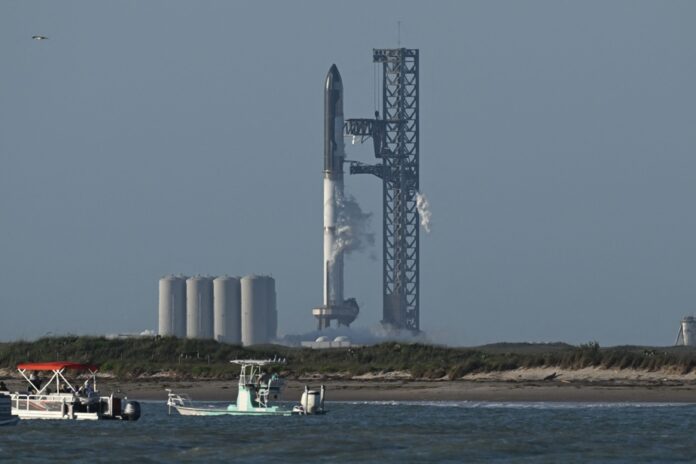(Starbase) The first take-off of the world’s largest rocket, Starship, developed by SpaceX for trips to the Moon and Mars, will be retried on Thursday after a last-minute postponement on Monday due to a technical problem.
The new firing window will open Thursday at 8:28 a.m. local time (9:28 a.m. EST) for just over an hour, the company said. The launch of this giant is to take place from the Starbase space base, in the far south of Texas in the United States.
From its height of 120 meters, Starship belongs to the category of super-heavy launchers, capable of transporting more than 100 tons of cargo into orbit. Its take-off power must be more than twice that of the legendary Saturn V, the Apollo lunar program rocket (111 meters).
Monday morning, the weather conditions were ideal and the filling of the rocket with its cryogenic fuel, liquid oxygen and methane, went as planned.
But “one valve appears to be frozen,” SpaceX boss Elon Musk eventually tweeted before the postponement was officially announced, less than 10 minutes before the scheduled takeoff time.
“We learned a lot today,” he said regardless.
This black and silver mastodon has never flown in its full configuration, with its super-powerful first stage, called Super Heavy.
Only the second stage of the vehicle, the Starship spacecraft which by extension gives its name to the entire rocket, has carried out suborbital tests (at an altitude of approximately 10 km).
The flight plan for the new test is as follows: approximately three minutes after takeoff, Super Heavy should detach and fall back into the waters of the Gulf of Mexico. The Starship must then turn on its six engines and continue its ascent on its own, up to an altitude of approximately 150 km. After having made a little less than a turn of the Earth for about an hour, it must fall back into the Pacific Ocean.
But this is the “best case scenario,” SpaceX said, so uncertain is the outcome of the test flight.
If during the preparations “we see anything that worries us, we will postpone the flight,” Elon Musk warned on Sunday. And reaching orbit on the first try is highly unlikely, he warned.
The billionaire was content to hope that the test, the main purpose of which is to collect as much data as possible for the following prototypes, would not destroy the launch pad.
His fear: that one of Super Heavy’s 33 Raptor engines would explode and cause a “domino effect” by spreading to others. “It would surely take several months to rebuild the launch pad if we melt it down,” he explained.
This inaugural flight will be followed very closely by NASA. The American space agency has chosen this spacecraft to land its astronauts on the Moon for the first time in more than half a century, during the Artemis 3 mission officially scheduled for 2025.
The astronauts will blast off separately aboard NASA’s new mega-rocket, SLS (98 meters high, with take-off power nearly half that planned for Starship).
They will travel to the Moon in the Orion capsule, which will then dock with the Starship spacecraft, previously placed in lunar orbit. It is he who will bring the astronauts down to the surface of the Moon. Without this lander, Artemis 3 cannot take place.
In the future, the new rocket must be fully reusable. Super Heavy will have to return to land against his launch tower, equipped with arms to catch him.
The Starship spacecraft will have to return to Earth using retrorockets. It was this maneuver that had been attempted several times in 2020 and 2021. Several prototypes had then descended too quickly, and had hit the ground in impressive explosions – before one of them finally succeeded in landing.
The idea of a reusable launcher, Elon Musk’s grand strategy, is to cut prices. Each Starship flight could ultimately cost only “a few million” dollars, he said Sunday.
The rocket already has customers: American billionaire Jared Isaacman will be flying its first crewed flight.
Another billionaire, the Japanese Yusaku Maezawa, and the American entrepreneur Dennis Tito (the first space tourist in history), have also announced that they will board for a trip around the Moon.
But for Elon Musk, Starship is above all the ship that must allow humanity to become multiplanetary: “We have an arduous path of two or three years ahead of us […] but in the end we should have something that allows us to set up a base on the Moon and on Mars. »


















